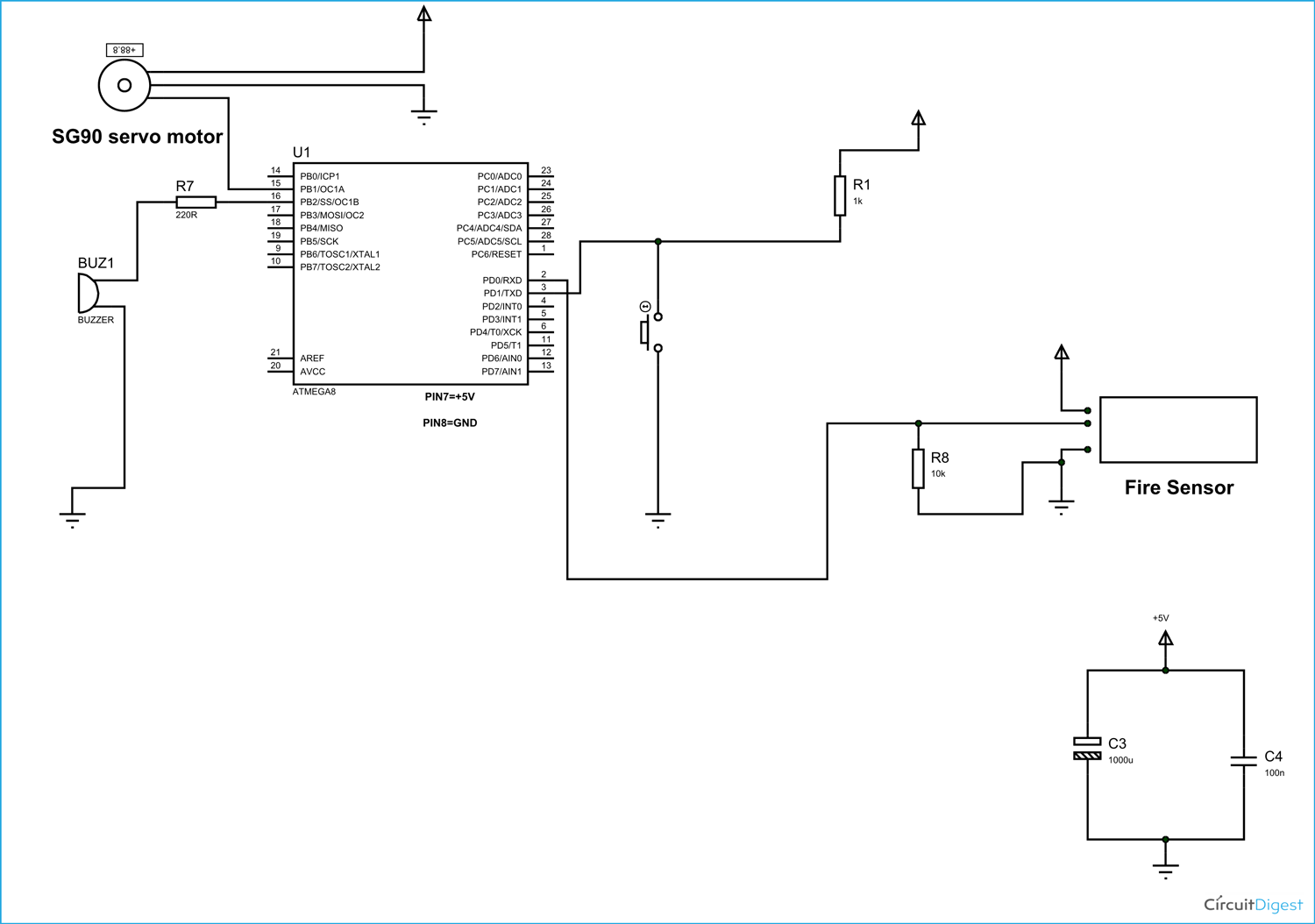Summary of Fire Alarm System using AVR Microcontroller
This project describes building a Fire Alert System using an ATMEGA8 microcontroller and an IR-based fire sensor mounted on a servo motor. The servo rotates 180 degrees continuously, providing over 270 degrees of fire detection coverage. When the fire sensor detects a flame, it sends a high pulse to the microcontroller, triggering an alarm that can be reset by a button. The system uses PWM signals generated via the Fast PWM method on the ATMEGA8 to control servo movement, enhancing detection range. The design aims for simplicity and cost-effectiveness despite some sensor accuracy limitations.
Parts used in the Fire Alert System Project:
- ATMEGA8 microcontroller
- IR (Infrared) based Fire Sensor
- Servo motor (SG90)
- Buzzer
- Reset Button
- 10KΩ resistor
- 1KΩ resistor
- 220Ω resistor
- 100nF capacitor
- +5V power supply
- AVR-ISP Programmer
In this project, we are going to make a Fire Alert System using ATMEGA8 microcontroller and fire sensor. Fire sensor can be of any type, however we are using IR (Infrared) based Fire Sensor. Although IR based Fire Sensors have some disadvantages mostly of inaccuracy, it is the cheapest and easiest way to detect fire.
IR Based Fire sensors have lesser sensing vision, so we are going to mount the fire sensor on a servo motor. The Servo will be making 180 degrees pendulum rotations. With the Fire sensor mounted on it, we get a 270+ degrees fire sensing vision. The servo will be rotating continuously thus giving a complete room fire alert system. For more accuracy we can add a smoke sensor to the system. With that we could get higher accuracy.
Circuit Components
Hardware:+5v power supply, Servo motor (sg90), ATMEGA8, BUZZER, Button, 10KΩ resistor, 1KΩ resistor, 220Ω resistor, 100nF capacitor, AVR-ISP PROGRAMMER.
Software: Atmel studio 6.1, progisp or flash magic.
Circuit Diagram & Working
For the servo shaft to move left all the away we need to give 1/18 turn on ration, and for the shaft to rotate all the way to the left we need to give PWM with a duty ration of 2/18. We are going to program ATMEGA8 to give out a PWM signal which will rotate servo shaft to 180 and then to 0 after a certain delay.
During the complete time the Fire Sensor will be on and the controller will be on complete alert. If there is a fire, the sensor provides a high pulse this pulse when detected by controller it sets an alarm. The alarm will be turned off by pressing a reset button which is connected to it. [Also check: Fire Alarm Circuit using Thermister]
In atmega8 for three PWM channels, we have designated three pins. We can only take PWM output at these pins only. Since we are using PWM1 we should take PWM signal at OC1A pin (PORTB 1st PIN). As shown in the circuit diagram, we are connecting the servo signal to OC1A pin. Here another thing is over three PWM channels, two are 8-bit PWM channels and one 16-bit PWM channel. We are going to use a 16-bit PWM channel here.
In ATMEGA there are couple of ways to generate PWM, they are
1. Phase correct PWM.
2. Fast PWM.
Here we are going to keep everything simple, So we are going to use FAST PWM method to generate the PWM signal.
First to choose the frequency of PWM, This depend on application usually, for a LED any frequency greater than 50Hz would do. For that reason we are choosing the counter clock 1MHZ.So we are choosing no prescalar. A prescalar is a number which is so selected to get a lesser counter clock. For example if the oscillator clock is 8Mhz, we can chose a prescalar of ‘8’ to get a 1MHz clock for counter. The prescalar is selected based on frequency. If we want more time period pulses we have to chose higher prescalar.
For more detail: Fire Alarm System using AVR Microcontroller


